Programmes Rescue Archaeological Investigations along the Course of the Future A11 Zagreb to Sisak Motorway
Zagreb City Museum responded to the invited competition of the Ministry of Culture of the Republic of Croatia to conduct rescue archaeological investigations along the course of the future Zagreb – Sisak motorway. The museum was considered an institution with great experience and capable of successfully organising, running and giving logistic support to a big project like this. And so Zagreb City Museum signed contracts with the Ministry of Culture to conduct the investigation.
From 2006 to 2009 the museum carried out investigations at several sites located along the course of the future motorway belonging in geographical terms to the Turopolje region and administratively to Zagrebačka County. This means the site called Šepkovčica, an area of 50,000 square metres, investigated in the period from 2006 to 2008; the sites Okuje I, II, Ia, IIa and IIIb, with a total area of 49,000 square metres; and the site of Mraclinska Dubrava, with an area of 2,800 square metres, investigated in 2008 and 2009.
The head of the investigation was Aleksandra Bugar, archaeologist and curator at Zagreb City Museum, who had acquired experience on big rescue archaeology projects relating to the motorways of Slovenia and in a number of other sites in Croatia.
During the long-lasting investigations, which were highly demanding in terms of organisation, extensive in their scope, and very complex in professional and technical terms, the large expert team was composed of archaeologists and many ABDs and students of the Archaeology Department of Zagreb University. The core professional team, along with the head of the research, consisted of Želimir Škoberne, museum adviser, and Boris Mašić, senior curator, as consultants, Iva Marochini, an outsource ZCM consultant, as well as archaeologists from the firm Kaducej d.o.o., Josip Burmaz, Dženi Los, Nikša Vujnović, Nikolina Antonić and Anita Sičić, who made an enormous contribution to the successful conducting of the archaeological investigations. Also taking part in the research was a numerous auxiliary technical crew and a team of manual labourers for the excavations done by hand. On a daily basis, there would be a team of over 100 people on average working on the sites. A large number of domestic and foreign experts were engaged on matters of assessment and analysis, conservation and restoration.
The operations are still going on, studying the finds from prehistoric, ancient and medieval periods found at these sites; how demanding this task is can be seen not only in the process of identification and evaluation, but also in the number of objects. There are more than 100,000 individual potsherds, over 800 metal objects, about 150 glass and bone objects, and over 330 ancient coins, wooden cladding from 18 wells, countless amounts of daub, brick and tile fragments, animal bones, slag and so on.
RESULTS OF THE INVESTIGATIONS
The Šepkovčica Site
 The site of Šepkovčica is located in the farmland of the settlements Gradići and Donja Lomnica, parallel to the Zagreb-Sisak railway line. Archaeological research has confirmed that this is one of the most important sites in the area of NW Croatia, and we would in fact venture to say much wider than that. In a technically and methodologically very demanding process of investigating multilayer vertical stratigraphy (meaning in real terms down to 3 metres deep) and at part of the site with a complex horizontal stratigraphy, on a site with a rather large area, the archaeological investigations resulted in very numerous, rich and extremely varied finds from the prehistoric, ancient and medieval periods.
The site of Šepkovčica is located in the farmland of the settlements Gradići and Donja Lomnica, parallel to the Zagreb-Sisak railway line. Archaeological research has confirmed that this is one of the most important sites in the area of NW Croatia, and we would in fact venture to say much wider than that. In a technically and methodologically very demanding process of investigating multilayer vertical stratigraphy (meaning in real terms down to 3 metres deep) and at part of the site with a complex horizontal stratigraphy, on a site with a rather large area, the archaeological investigations resulted in very numerous, rich and extremely varied finds from the prehistoric, ancient and medieval periods.
One particular feature of interest is the find of 13 wells with wooden structures of a circular or square plan from all three periods present at the site, as well as the find of 8 pits with animal burials of cattle placed on their sides with bent legs, of, we assume, a ritual nature. Remains of an Aeneolithic settlement of Lasinja culture and of Bronze Age settlements (Litzen pottery and ceramics of the urnfield culture) with more than 800 pits dug, most of which are smaller pits for pillars, while the rest are waste or working pits, drainage channels, wells and fireplaces all belong to the prehistoric period. A large quantity of potshards were found, daub, animal bones and to a smaller extent lithic artefacts.
 The ancient finds are numerous – they are defined by two cemeteries with a total of 56 graves. One is a combined skeleton and cremation cemetery and has been dated to the 1st to the 4th century; the other is the remains of a Noricum/Pannonia tumulus destroyed by ploughing within which there are urn and cremation graves with many grave gifts typical of the Roman period of the second half of the 1st and in the second century AD (urns, ceramic jugs with one or two handles, bowls, plates, pots with a vertical neck, beakers, cups with thin walls, coins, bronze fibulae, glass vessels). The remains of a Late Antiquity settlement of the rural type have been mostly defined over an area of about 12,000 square meters and in addition to this various ancient settlement structures are located elsewhere within the area investigated. More than 600 different excavations for pits have been defined. There are foundation trenches of a rectangular structure, excavations for the pillars of the above-ground structures of features, working and waste pits and trenches, regular rows of holes dug for the posts of one-time fences, numerous fire places, wells and drainage channels.
The ancient finds are numerous – they are defined by two cemeteries with a total of 56 graves. One is a combined skeleton and cremation cemetery and has been dated to the 1st to the 4th century; the other is the remains of a Noricum/Pannonia tumulus destroyed by ploughing within which there are urn and cremation graves with many grave gifts typical of the Roman period of the second half of the 1st and in the second century AD (urns, ceramic jugs with one or two handles, bowls, plates, pots with a vertical neck, beakers, cups with thin walls, coins, bronze fibulae, glass vessels). The remains of a Late Antiquity settlement of the rural type have been mostly defined over an area of about 12,000 square meters and in addition to this various ancient settlement structures are located elsewhere within the area investigated. More than 600 different excavations for pits have been defined. There are foundation trenches of a rectangular structure, excavations for the pillars of the above-ground structures of features, working and waste pits and trenches, regular rows of holes dug for the posts of one-time fences, numerous fire places, wells and drainage channels.
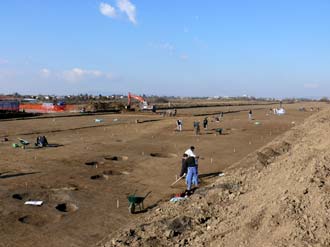 One of the most important finds on the site consisted of the remains of a medieval settlement that spread over an area of 15,000 square meters, dating to the period from the 9th to the 15th century. This is one of the most extensive settlement finds of this period in Croatia. More than 800 differently sized pit excavations have been defined; most of them are classified as excavations for posts, while the rest are medium-sized and large pits of various functions (dwelling place, working, waste, fire place, bread ovens, wells, drainage channels). Four types of structure have been picked out according to their organisation of posts and their accompanying pits. A large quantity of pottery has been found, mainly of pots, many fragments of which are decorated with wave shaped features – either combed or single, a decoration done with a little wheel or incised with parallel lines. Apart from pottery, a large amount of animal bones were found, some of which belong to the extinct bos primigenius / wild ox (or tur from which tradition derives the name Turopolje). In addition a large number of metal objects were discovered, of iron knives and tools, two bronze S-links, one moulded earring of the Volyn type and one bronze granulated pendant in the shape of a little bell.
One of the most important finds on the site consisted of the remains of a medieval settlement that spread over an area of 15,000 square meters, dating to the period from the 9th to the 15th century. This is one of the most extensive settlement finds of this period in Croatia. More than 800 differently sized pit excavations have been defined; most of them are classified as excavations for posts, while the rest are medium-sized and large pits of various functions (dwelling place, working, waste, fire place, bread ovens, wells, drainage channels). Four types of structure have been picked out according to their organisation of posts and their accompanying pits. A large quantity of pottery has been found, mainly of pots, many fragments of which are decorated with wave shaped features – either combed or single, a decoration done with a little wheel or incised with parallel lines. Apart from pottery, a large amount of animal bones were found, some of which belong to the extinct bos primigenius / wild ox (or tur from which tradition derives the name Turopolje). In addition a large number of metal objects were discovered, of iron knives and tools, two bronze S-links, one moulded earring of the Volyn type and one bronze granulated pendant in the shape of a little bell.
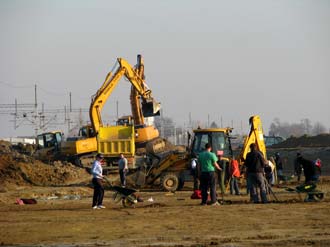 The first results of the investigations at Šepkovčica were shown at the exhibition “Respect the traces of us” held in Zagreb City Museum in January 2007.
The first results of the investigations at Šepkovčica were shown at the exhibition “Respect the traces of us” held in Zagreb City Museum in January 2007.
The site was presented in a lecture at the 13th Annual Meeting of the European Association of Archaeologists – AEE – held in Zadar in September 2007 and at the Ancient Sepomaia Days in Umag in August 2007.
The site was also covered by the daily press (Jutarnji list, News from Velika Gorica) and by Croatian Radio Television in the programme Moment of Perception in May 2007.






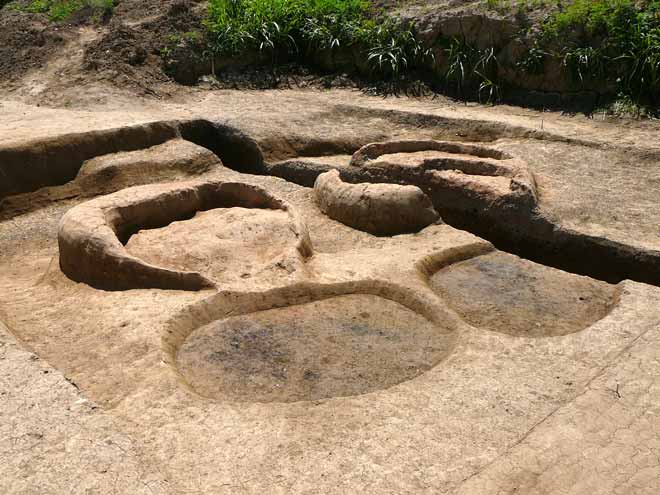
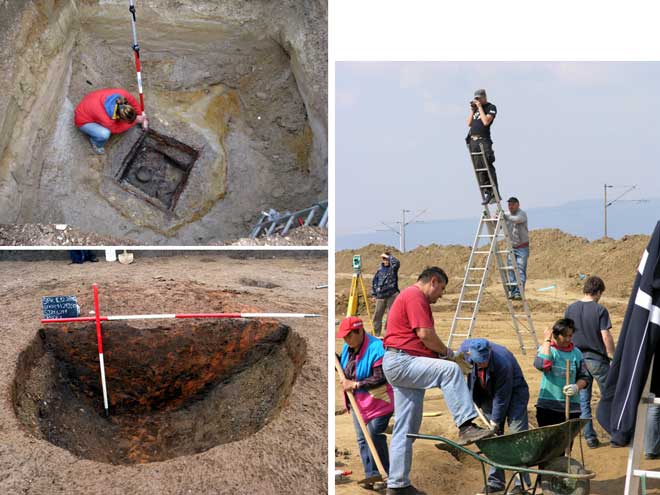
The Okuje Site (Okuje I, II, Ia, IIa and IIIb)
 The archaeological site of Okuje is located on the farmlands of the settlements of Okuje and Mraclin. Archaeological research has confirmed that it is a site that was settled from the Bronze Age on, via the La Tène culture, the ancient period and the High Middle Ages, which resulted in great number of important finds. We would cite as particularly interesting – as in the Šepkovčica site – the find of five wells with wooden structures from the ancient period. The prehistoric period claims settlement remains from the Bronze Age, that is, finds of Litzen culture. A large number of potsherds were found, with daub and, to a lesser extent, lithic artefacts.
The archaeological site of Okuje is located on the farmlands of the settlements of Okuje and Mraclin. Archaeological research has confirmed that it is a site that was settled from the Bronze Age on, via the La Tène culture, the ancient period and the High Middle Ages, which resulted in great number of important finds. We would cite as particularly interesting – as in the Šepkovčica site – the find of five wells with wooden structures from the ancient period. The prehistoric period claims settlement remains from the Bronze Age, that is, finds of Litzen culture. A large number of potsherds were found, with daub and, to a lesser extent, lithic artefacts.
 The Roman period finds are numerous; two cemeteries have been defined, as has a series of dwellings distributed over almost the whole area of the site. What is particularly interesting and important is that some of the burials of this period also contain finds of distinctly La Tène features, and therefore we are concerned with the period of the 1st century BC and the first century AD, a time of great turmoil, of the Roman occupation and the initial Romanisation. A group of 13 cremation graves within a rectangular system of trenches dates from the turn of the century. A second group also consists of cremation graves and has a total of 14 graves. It dates to the 1st to the 2nd century. The remains of a Roman period settlement of the rural type with varying excavations for the posts of the above-ground structures of features, with working and waste pits and trenches, regular rows of diggings for the posts of the one-time fences, with fire places and wells. There are many pottery finds, of iron tools to a lesser extent, and a few bronze objects – parts of fibulae, coins, daub, bits of querns and so on. Also important is the discovery of an ancient road that is thought to be part of the ancient via publica from Emona to Siscia.
The Roman period finds are numerous; two cemeteries have been defined, as has a series of dwellings distributed over almost the whole area of the site. What is particularly interesting and important is that some of the burials of this period also contain finds of distinctly La Tène features, and therefore we are concerned with the period of the 1st century BC and the first century AD, a time of great turmoil, of the Roman occupation and the initial Romanisation. A group of 13 cremation graves within a rectangular system of trenches dates from the turn of the century. A second group also consists of cremation graves and has a total of 14 graves. It dates to the 1st to the 2nd century. The remains of a Roman period settlement of the rural type with varying excavations for the posts of the above-ground structures of features, with working and waste pits and trenches, regular rows of diggings for the posts of the one-time fences, with fire places and wells. There are many pottery finds, of iron tools to a lesser extent, and a few bronze objects – parts of fibulae, coins, daub, bits of querns and so on. Also important is the discovery of an ancient road that is thought to be part of the ancient via publica from Emona to Siscia.
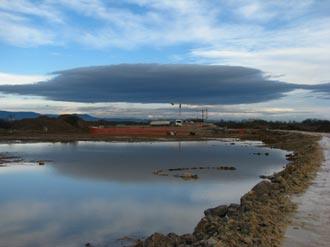 One of the biggest finds at the site consists of the remains of a medieval settlement dating to the 10th to the 15th century. Several different pit excavations have been defined, a large number of them being holes for posts, while others are medium sized and larger pits of various functions (residential – parts of houses, working and waste pits, fire places, drainage channels). A large amount of pottery has been found, of pots, lids, beakers, jugs and the like. By a study of the references we found that the village of Okuje, once part of the Vukovina estate of the Drašković family, was from 1634 to 1709 owned by the Order of the Poor Clares, whose convent once lay in the building today occupied by Zagreb City Museum. Coincidences of this kind gladden the hearts of both experts and ordinary people. The finds are in the study phase, and also of the preparation for reports and other forms of presentation of the results of the finds (the announcement and preparation of an exhibition).
One of the biggest finds at the site consists of the remains of a medieval settlement dating to the 10th to the 15th century. Several different pit excavations have been defined, a large number of them being holes for posts, while others are medium sized and larger pits of various functions (residential – parts of houses, working and waste pits, fire places, drainage channels). A large amount of pottery has been found, of pots, lids, beakers, jugs and the like. By a study of the references we found that the village of Okuje, once part of the Vukovina estate of the Drašković family, was from 1634 to 1709 owned by the Order of the Poor Clares, whose convent once lay in the building today occupied by Zagreb City Museum. Coincidences of this kind gladden the hearts of both experts and ordinary people. The finds are in the study phase, and also of the preparation for reports and other forms of presentation of the results of the finds (the announcement and preparation of an exhibition).
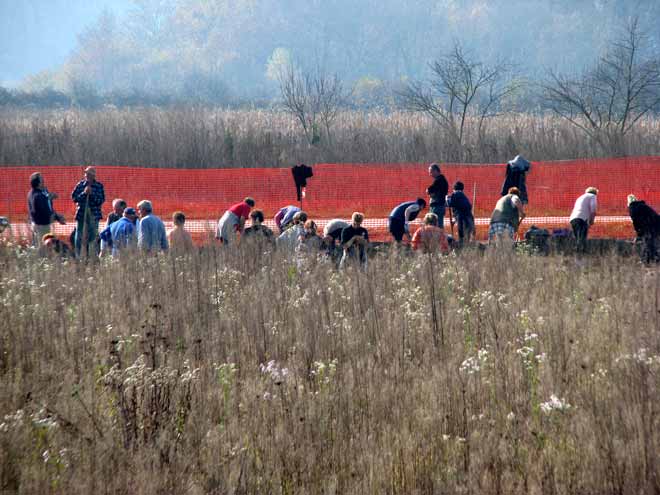



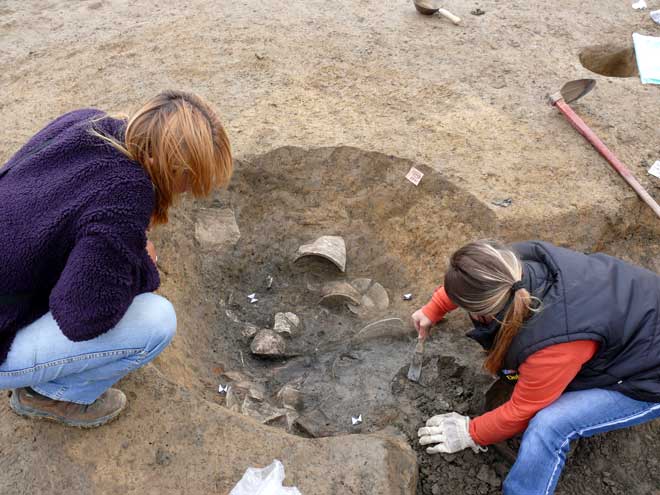


The Mraclinska Dubrava site
 The archaeological site of Mraclinska Dubrava lies in the forest of the same name that belongs administratively to the municipality of Mraclin. Since the wood is the site of a really large number of ancient funeral tumuli of the Noricum/Pannonia type, the fact that the route of the motorway is to pass through was addressed with a great deal of circumspection. Field surveys determined one tumulus, which was carefully explored, as was the area in its immediate surrounds. Still, the results showed that this was not an ancient site, but part of an industrial plant for brickmaking, probably from the end of the 19th or early 20th century. Remains of walls and the foundations of the plant were found, large waste pits and area for processing and drying the raw bricks.
The archaeological site of Mraclinska Dubrava lies in the forest of the same name that belongs administratively to the municipality of Mraclin. Since the wood is the site of a really large number of ancient funeral tumuli of the Noricum/Pannonia type, the fact that the route of the motorway is to pass through was addressed with a great deal of circumspection. Field surveys determined one tumulus, which was carefully explored, as was the area in its immediate surrounds. Still, the results showed that this was not an ancient site, but part of an industrial plant for brickmaking, probably from the end of the 19th or early 20th century. Remains of walls and the foundations of the plant were found, large waste pits and area for processing and drying the raw bricks.
The Mraclin area is known for the rich strata of high quality clay, and there were many brickworks here in the 19th and 20th century; most of the products were transported to Zagreb, and in fact Zagreb was made of them in the 19th and early 20th century. This find is an example of our recent past, modest in its remains, but part of a mosaic that once again recalls the interconnections between Zagreb and Turopolje, which was once called Campus Zagrabiensis – Zagreb Field.

Aleksandra Bugar
Related published papers
Bugar, Aleksandra. Naselje ranog srednjeg vijeka Velika Gorica-Šepkovčica = Frühmittelalterliche Siedlung Velika Gorica-Šepkovčica. // Srednji vek - arheološke raziskave med Jadranskim morjem in Panonsko nižino / Mitja Guštin (ed.). Ljubljana : Narodni muzej Slovenije ; Inštitut za dediščino Sredozemlja Znanstveno-raziskovalnega središča Univerze na Primorskem, 2008, pp. 179-193.
Bugar, Aleksandra. Lokalitet: Šepkovčica = Site: Šepkovčica. // Hrvatski arheološki godišnjak, 5(2008) / editor Jasen Mesić. Zagreb : Ministry of Culture, 2009, pp. 269-273.
Hincak, Zdravka; Damir Mihelić; Aleksandra Bugar. Cremated Human and Animal Remains of the Roman Period – Microscopic Method of Analysis (Šepkovčica, Croatia). // Collegium Antropologicum. 31, 4(2007), pp. 1127–1134.
Bugar, Aleksandra. Two Mediaeval Wells from the Site of Šepkovčica. // Vjesnik Arheološkog muzeja u Zagrebu. 44, 1(2011), pp. 161-178.
Pavlović, Ana. Numismatic Finds from the Šepkovčica Site. // Opuscula Archaeologica. 35, 1(2011), pp. 263-296.

